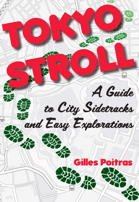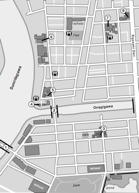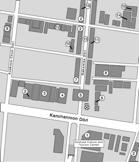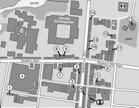











Tokyo Stroll Supplement: Tsukudajima and Tsukishima

This page is for locations in the Tsukudajima and Tsukishima area of Tokyo. This neighborhood is not part of my book Tokyo Stroll.
For information on Tokyo Stroll and this web supplement see Tokyo Stroll Supplement home page
For users of the Organic Maps, Maps.Me and Google Maps apps the items below have bookmarks you can import into those apps to make navigation easier.
Instructions and links are on the Viewing Locations in Organic Maps, Maps.Me, Google Maps, or Google Earth page.
Some entries on this page may include a note that says "Description to be added soon ." These entries are for items I felt should be listed even if the description is not ready to assist those who wish to plan a trip. When possible I included a link to an official web page, I suggest also doing web searchs for more information.
Tsukudajima Area
Tsukudajima (佃島)
Originally a small island at the mouth of the Sumidagawa. Tsukudajima is named after Tsukudamura, an area in Setsu Province from which the first Tokugawa shogun, Ieyasu, recruited skilled fishermen to relocate to Edo and provide fish for his castle. The descendants of the original fishermen still live on what is now part of a larger island as landfill projects greatly expanded the fill in 1892 connecting the area with other local islands. Today the areas designated as Tsukuda 1-chōme and Tsukuda 2-chōme cover the original island. However there is still a tidal canal for fishing boats, with its own storm gate, which wraps around part of the former island so water is still very much a part of this community. This area with its long history feels less like a part of a big city and more like a separate village which happens to be part of Tokyo. The buildings on the former island are mainly of recent construction, mainly two stories on small lots, with a few older dwellings here and there. The surrounding vicinity has a large amount of high rise apartment and condominium buildings creating a contrast with this area. There is a culinary connection to this area as tsukudani originated here.
Funadama Shrine / Funadama Jinja (船魂神社)
A shrine to the funadama, a guardian deity that safeguards ships on the sea. This shrine is in the grounds of Sumiyoshi-jinja and to the right of the main shrine. Shrines to funadama can be found on land or on ships, when enshrined on a ship it is done at the mast by using a variety of items. This particular shrine was established in 1863. Funadama are generally held to be female and as the funadama is a jealous deity women are discouraged from being on ships with a shrine on them.
NEAREST TRAIN/SUBWAY STATION: Tsukishima Station (Tokyo Metro Yūrakuchō Line, Toei Ōedo Line)
Irifune Inari Shrine / Irifune Inari Jinja (入船稲荷神社)
An Inari shrine in the grounds of Sumiyoshi-jinja to the right and behind of the main shrine. This shrine protects the arrival of ships, something of great value to a fishing community.
NEAREST TRAIN/SUBWAY STATION: Tsukishima Station (Tokyo Metro Yūrakuchō Line, Toei Ōedo Line)
Ishikawajima Lighthouse (石川島灯台)
A replica of a lighthouse built in 1866 on Ishikawajima, the northern part of Tsukudajima at that time and the location of shipyards. The replica is in Tsukuda Park and below it are the park restrooms. This was also the location of a labor camp established in the 18th century for minor criminals and vagabonds. The prisoners were lectured on ethics, trained in trades, paid for their work, and upon release employment would be found for them.
NEAREST TRAIN/SUBWAY STATION: Tsukishima Station (Tokyo Metro Yūrakuchō Line, Toei Ōedo Line)
Ishikawajima Museum / Ishikawajima shiryoukan (石川島資料館)
A small museum on the history of the shipyards that were in this area from the 1853 to 1979. While this operation originated as a shipyard the manufacturing expanded into other areas such as airplanes, automobiles, bridges, and more. The history of all of this is illustrated by a series of exhibits with photographs, models, and dioramas. The museum is operated by IHI, the company which owned the shipyard when it shut down.
NEAREST TRAIN/SUBWAY STATION: Tsukishima Station (Tokyo Metro Yūrakuchō Line, Toei Ōedo Line)
WEB: http://www.ihi.co.jp/shiryoukan/
Katsuozuka aka Bonito Mound (鰹塚)
A memorial stone to katsuo set up by the Japan Katsuobushi Association in 1953 when this area still played a significant role in the fishing industry. The mound is easy to identify, a low stone fence surrounds a base of black stone and an upright brown stone with the two kanji for katsuo (鰹) and tsuka (塚). Once a year a memorial service for the katsuo killed to make katsuobushi is held.
NEAREST TRAIN/SUBWAY STATION: Tsukishima Station (Tokyo Metro Yūrakuchō Line, Toei Ōedo Line)
Marukyu (丸久)
This business has been making and selling tsukudani made from seaweed, fish, and other seafood since it first set up shop in 1859. They replaced their old building in 2009 out of concerns that it was not fully earthquake safe. The new store has a lattice motif and a tall attractive blue noren out front when they are open. The still make the tsukudani by hand producing enough each day to hopefully supply the next day's stock, they do sell out at times.
NEAREST TRAIN/SUBWAY STATION: Tsukishima Station (Tokyo Metro Yūrakuchō Line, Toei Ōedo Line)
WEB: http://marukyu-tsukudani.com
Monument of the Fifth Master of Senryū (五世川柳句碑)
The Fifth Master of Senryū was Mizutani Rokutei. Mizutani's parents died when he was a child, he was then raised by relatives on Tsukudajima. He studied senryū under Karai Soemon and took Namagusa Itatsukuri as his literary name. When he was fifty he became the fifth master of senryū. The monument is inscribed with “One's heart should be soft but firm.”
NEAREST TRAIN/SUBWAY STATION: Tsukishima Station (Tokyo Metro Yūrakuchō Line, Toei Ōedo Line)
Mori Inari Shrine / Mori Inari Jinja (森稲荷神社)
The name of this Inari shrine shows a connection with the family of Mori Magoemon the first head of the fishermen who relocated to Edo and founded this community. The family name Mori had been given to Magoemon by Tokugawa Ieyasu as a reward for his strong loyalty.
NEAREST TRAIN/SUBWAY STATION: Tsukishima Station (Tokyo Metro Yūrakuchō Line, Toei Ōedo Line)
Sumiyoshi Shrine / Sumiyoshi Jinja (住吉神社)
This Shinto shrine was built in 1646 by the local fishing families when the area was the island of Tsukudajima. Sumiyoshi Jinja is a branch of the famous Sumiyoshi Taisha in Osaka. The shrine was constructed to face Edo Castle, now of course it faces the Imperial Palace. The approach to the shrine has two torii the first being at the river and is clad in copper plates, the second one closer to the shrine is stone. The stone torii has a ceramic sign, an unusual feature as they are usually wood, the lettering was made in 1882 by prince Ippin Shijin Shinno, a famous calligrapher and director of the Shintō Kyōdōshoku. The building sports a straight roof an early shrine style that pre-dates the introduction of Buddhism. The building is wood with a copper plated roof. On the grounds there is a beautifully carved shelter for the temizuya with motifs of fishermen and ships. The shelter carvings are said to have been done by none other than Sharaku, there is also a memorial stone to him on the grounds. One can also see some smaller sub-shrines, an unusual brick kura store house for shrine mikoshi, the Katsuozuka, and a wisteria trellis where I once found a fat dove perched inches from my face.
NEAREST TRAIN/SUBWAY STATION: Tsukishima Station (Tokyo Metro Yūrakuchō Line, Toei Ōedo Line)
Tenyasu (天安)
A shop specializing in making and selling tsukudani since 1837. Their products are all seafood based made from shellfish, seaweed, and fish. They even have one made from eel. The store is in an old two story wooden building from the early Showa Period, such may change in the future if the owners ever decide to rebuild. Depending on the time of year and if it is a warm and sunny day they may have their long hoike awning which reaches the ground in front of the door.
NEAREST TRAIN/SUBWAY STATION: Tsukishima Station (Tokyo Metro Yūrakuchō Line, Toei Ōedo Line)
WEB: http://tenyasu.jp
Tsukuda Machikado Museum (佃まちかど展示館)
The building for the storage and display of a 3.75-ton Sengan Mikoshi, the early 19th century wooden masks Ryuko and Kurokama, photographs, a reproduction of an Edo Period map of the area, as well as other items. Legend has it the masks quenched a fire in the store house they had been in at that time, they are also credited by locals for having preserved the neighborhood from the fires of the Great Kantō Earthquake and WWII fire bombings. The items are always viewable through the glass doors in front of them, on certain occasions the doors are open so you can get a better view. Next to museum is a monument to the ferry across the Sumidagawa that used to service the island. The street in front of this museum is also where the local unique form of the Bon odori takes place.
NEAREST TRAIN/SUBWAY STATION: Tsukishima Station (Tokyo Metro Yūrakuchō Line, Toei Ōedo Line)
WEB: http://chuoku-machikadotenjikan.jp/tenjikan/tsukuda/
Tsukuda Namiyoke Inari Daimyōjin & Osaki Inari Jinja (波除於咲稲荷大明神 & 於咲稲荷神社)
Two shrines which are next to each other in the same compound and share one torii. The dates of these shrines in unclear. Given the name of one there is a likely connection with Tsukiji's Namiyoke Inari Jinja. Both shrines are here to protect fishermen at sea and the island from waves, a very real hazard during storms in such a low lying place. Namiyoke means "protection from waves"
NEAREST TRAIN/SUBWAY STATION: Tsukishima Station (Tokyo Metro Yūrakuchō Line, Toei Ōedo Line)
Tsukuda Park (佃公園)
When the River 21 condo development took place a high embankment, a super levee, was constructed as part of the project. The South West area of the embankment was designated for this Tsukuda Park. On the river side you can go down the stairs to be fairly close to the water, in the park are the replica of the Ishikawajima Lighthouse, open plazas with benches so you can take a load off your feet before continuing your stroll, a large pond, and trails either along the river or higher up through the greenery.
NEAREST TRAIN/SUBWAY STATION: Tsukishima Station (Tokyo Metro Yūrakuchō Line, Toei Ōedo Line)
Tsukuda Tendai Jizōson (佃天台地藏尊)
A very attractive small shrine housing a statue of Jizō placed here in 1738. The shrine is easy to miss as your access to it is via a very narrow passageway between homes. Be very quiet so as to not disturb the residents. The passageway is so narrow I had to turn sideways to exit opposite from where I had entered. The site is believed to have been chosen as it was one of the highest locations on the island. Originally exposed to the elements the Jizo is now covered with a roof literally built around a centuries old ginkgo tree extending through and well beyond the roof. The passageway can be located by looking for banners at each end and the tree that towers over the nearby homes.
NEAREST TRAIN/SUBWAY STATION: Tsukishima Station (Tokyo Metro Yūrakuchō Line, Toei Ōedo Line)
Tsukudagen Tanakaya (佃源田中屋)
Established in 1843 and specializing in making and selling tsukudani this shop has a pleasant old-fashioned feel with its old-style entrance on a newer style building. The interior is wood paneled with glass cases displaying their products, an antique clock adds a certain flavor to the room.
NEAREST TRAIN/SUBWAY STATION: Tsukishima Station (Tokyo Metro Yūrakuchō Line, Toei Ōedo Line)
Tsukudakobashi (佃小橋)
A small elegant single arched bridge with a red railing and copper topped posts over the Tsukudajima tidal canal, the current bridge dates from 1984 The area near the bridge is a mooring spot for several boats owned by locals and a small park with a children's playground at one end. In the Spring the cherry trees here provide a place for flower viewing.
NEAREST TRAIN/SUBWAY STATION: Tsukishima Station (Tokyo Metro Yūrakuchō Line, Toei Ōedo Line)
Urushigei Nakajima (漆芸中島)
The shop of a craftsman specializing in wood and lacquerware ranging from small items to furniture. The business was founded in the early 18th century. The shop is famous for their hand crafted eight-sided hashi which are easy to use. The hashi are made from the previous generation's stock of rare aged hardwoods. Urushigei Nakajima moved to Tsukudajima after being burned out of their old location during WWII. For many years the business was housed in a small older building with the sales right on the sidewalk with an awning and folding tables set out to display the goods. They rebuilt during the COVID pandemic and now have a very nice modern building.
NEAREST TRAIN/SUBWAY STATION: Tsukishima Station (Tokyo Metro Yūrakuchō Line, Toei Ōedo Line)
WEB: http://www.urusigei-nakajima.com
Tsukishima Area
Kachidoki-Toyomi Historical Archive Museum (勝どき・豊海歴史資料展示館)
Located in a park this small museum displays three neighborhood mikoshi that were made in 1935, a festival float with a taiko drum, and the local matoi are on display. The mikoshi and float were made by master artisan Asako Shuke. The display has three large windows to allow viewing the exhibited items directly from the street. The matoi belongs to the Group 6 Area 1 branch of the Edo Firemanship Preservation Association.
NEAREST TRAIN/SUBWAY STATION: Kachidoki Station (Toei Ōedo Line)
EVENTS: On the second Saturday and Sunday of each month from 10:00 - 16:00 the Taiyo no Marche "Market of the Sun" is held in this park.
WEB: http://chuoku-machikadotenjikan.jp/tenjikan/kachidoki_toyoumi/
Nishinaka Dōri (西仲通り四番街)
This street is informally known as Tsukishima Monja Street (月島もんじゃストリート) as it is lined mostly with restaurants specializing on the local treat monja. There are roughly 80 monjayaki restaurants to choose from. Just choose one that looks good. Be aware this is a dish you normally cook yourself, staff are often willing to help you learn how or just observe other customers. Depending on the restaurant they may do it for you, but that is not as much fun. Do fully expect your first attempts will be a little sloppy, but still tasty. The first time I went my Japanese friend did not know how to make it so the owner showed us how. There are many different kinds of monja on the menus so choose one which sounds interesting, or just at random. The bulk of the street has covered sidewalks so even if it is raining you can easily enjoy going there. You won't have much need for an umbrella as exits 3 and 10 from the Tsukishima subway station put you directly on the street.
NEAREST TRAIN/SUBWAY STATION: Tsukishima Station (Tokyo Metro Yūrakuchō Line, Toei Ōedo Line)
WEB (Tsukishima Monja Promotional Cooperative Society): http://www.monja.gr.jp
Nishinaka Dori Kōban (西仲通り四番街交番)
This is the oldest Tokyo kōban in use, built in 1921, the only older one still existing is part of the Edo-Tokyo Open Air Architectural Museum and not in use. This is also a very small kōban, the design is simple but with a streamlined look with its curved corners and has a slight art deco feel. It also has a welcoming homey feel to it with the potted plants near the entrance.
NEAREST TRAIN/SUBWAY STATION: Tsukishima Station (Tokyo Metro Yūrakuchō Line, Toei Ōedo Line)
Toyomi Fish Museum / Toyomi Osakana Museum (豊海おさかなミュージアム)
Description to be added soon
NEAREST TRAIN/SUBWAY STATION: Kachidoki Station (Tōei Ōedo Line)
WEB: https://museum.suisan-shinkou.or.jp
Tsukishima Kannon (月島開運観世音)
Established in 1951 this small Buddhist shrine is located deep inside the first floor of the same building as the local onsen near the police koban. Look for the red lanterns inside the building's hallway. People pray here to recover lost items and for healing.
NEAREST TRAIN/SUBWAY STATION: Tsukishima Station (Tokyo Metro Yūrakuchō Line, Toei Ōedo Line)
Tsukudaōhashi (佃大橋)
This bridge opened in 1964 connecting Tsukuda and Tsukishima on the East side of the Sumidagawa to Akashichō on the West side. Before that time locals had to walk a great distance or take a ferry across the river. The ferry service had existed from the Edo Period.
NEAREST TRAIN/SUBWAY STATION: Tsukishima Station (Tokyo Metro Yūrakuchō Line, Toei Ōedo Line)
Back to the Tokyo Stroll Supplement home page - Privacy Notice - Back to Gilles' home page
Created November 5, 2022 | Content last updated April 5, 2025